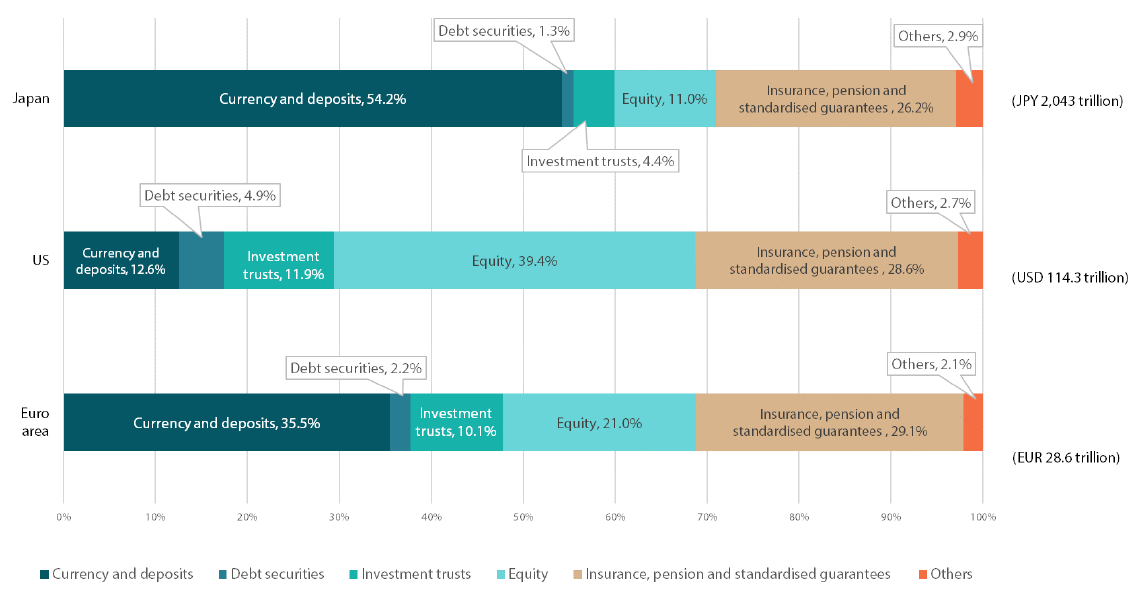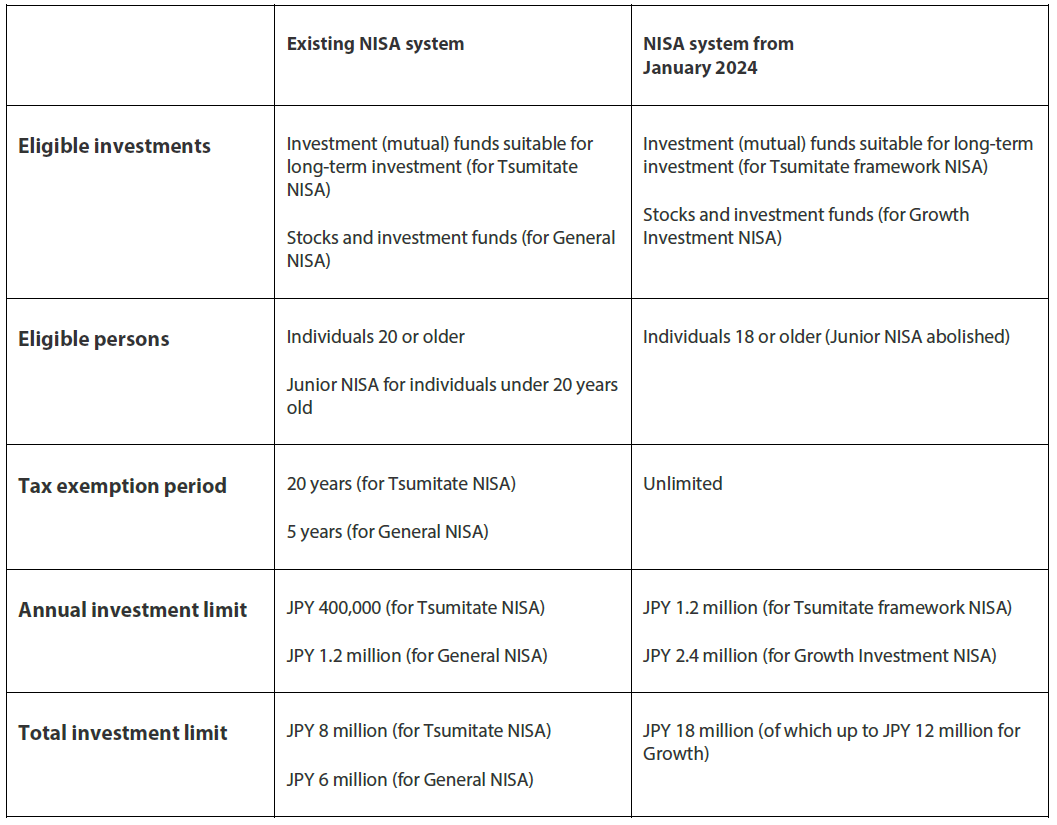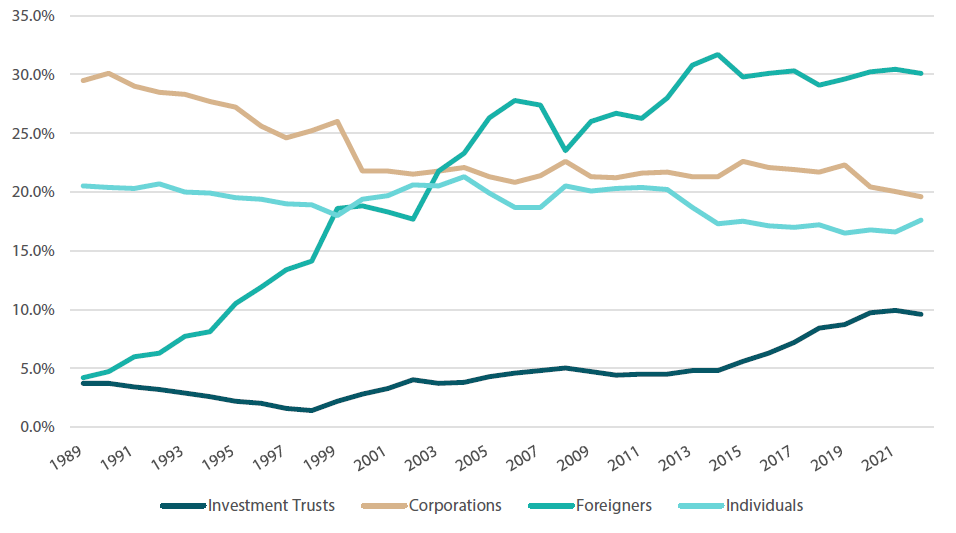Key Takeaways
- As the Japanese domestic tax-free savings scheme – the Nippon Individual Savings Account (NISA) – celebrates its tenth anniversary next year, the system is being given a bold revamp.
- The changes are expected to deliver an increased flow into mutual funds both international and domestic, and attract a younger generation of investors in one of the world’s most liquid markets in terms of household wealth.
With the Nippon Individual Savings Account (NISA) scheme celebrating its ten-year anniversary in 2024, recently announced changes to the scheme should help encourage further investment from Japanese investors. Japanese savings clearly present an enormous opportunity that has yet to be tapped, households hold approximately Japanese yen (JPY) 2 quadrillion in wealth (approx. EUR 12.9 trillion), with over half of that in savings accounts or cash. Only 17% of this is invested in equities, bonds or investment trusts (March 2023).1
Growing an equity culture by weaning Japan off its savings habit
The Japanese government has been keen to change Japan’s savings mindset for decades. The slogan “from savings to investments” was a campaign slogan in Japan as far back as 2001. Why is changing the savings culture into an equity culture so important? Chart 1 shows the different types of investments held by citizens in Japan, the US and the Euro area, respectively. As the chart demonstrates, 54.2% of Japanese households’ JPY 2.0 quadrillion yen (approx. EUR 12.9 trillion) in assets is kept as cash and deposits.
Chart 1: Japanese households hold approximately JPY 2 quadrillion in wealth

Source: Bank of Japan, 2023
Both in the US and the Eurozone, a strong investment culture encourages personal financial planning, emphasises retirement savings and driving longer-term wealth generation. It is therefore unsurprising that Japan’s policymakers have long been keen to wean Japanese citizens off their preference for cash savings and encourage greater investment into equities and other investment vehicles. The introduction of the NISA is one example of a programme designed to encourage domestic investors to create wealth, own a stake in successful companies and participate in the longer-term growth of their economy. Foreign investors, such as Warren Buffett, have helped to accelerate Japan’s recent bull market and greater participation by domestic investors looks to be creating a “virtuous circle” underpinned by a growing equity culture in Japan. Indeed, considering the size of Japan’s household wealth this transition could help fuel what we believe is a secular bull market in Japanese equities. To learn more about reforms Japan has made to unlock shareholder value, read Nikko AM’s Japan investment guide here.
The history of the NISA
The NISA began as a temporary scheme in 2014, and was modelled on the UK’s highly successful Individual Savings Account (ISA) system. Just as with the ISA, the NISA was designed to encourage people to convert their cash and bank deposits into long-term investments instead, particularly for retirement planning. All residents of Japan 20 or older, including non-Japanese nationals, are currently eligible to invest via the NISA scheme.
The NISA rules
The General NISA has a tax exemption period of five years and has a yearly investment contribution limit of JPY 1.2 million (approx. EUR 7,600), as well as a lifetime investment limit of JPY 6 million (approx. EUR 38,000).
In principle, dividends and gains from the sale of stocks and investment funds are currently taxed in Japan at a rate of 20%. Therefore, the tax-free status of NISA investments has been a significant incentive for those prepared to invest their money rather than keep it in a bank account.
With a General NISA, contributions can be invested into investment funds, equities and exchange-traded funds (ETFs) etc. The NISA benefits from tax-free growth for a five-year period which then resets.
Just as with the UK ISA, the NISA has evolved over time to increase contribution limits and to make it more widely available to Japanese citizens. For example in 2016, the Junior NISA was introduced which can be opened by parents and guardians for individuals under the age of 20. Junior NISAs have a yearly investment limit of JPY 800,000 (approx. EUR 5,100).
Then in 2018, another NISA investment option was created. The “Tsumitate” NISA is a more long-term, savings-type vehicle, designed for less sophisticated investors who plan on putting aside regular amounts over time. It aims to protect these investors by excluding investment vehicles that may be considered too volatile, complex or expensive.
Also, to encourage the idea of “investing and forgetting”, the Tsumitate NISA has a much longer (20-year) tax exemption period, with a yearly investment contribution limit of JPY 400,000 (approx. EUR 2,500) and a lifetime investment limit of JPY 8 million (approx. EUR 50,700). However, unlike the General NISA contributions can only be invested in qualified investment funds. A General NISA and a Tsumitate NISA cannot be used at the same time.
Revamping the NISA system in 2024
Back in 2022, Japanese Prime Minister Fumio Kishida made the following pronouncement: “I will promote a bold and fundamental shift from savings to investment, in order to double people’s incomes from asset investments”. He made this statement in the City of London, echoing the NISA’s UK-inspired roots.
As part of these reforms, the Japanese government is revamping the NISA system and making the scheme permanent. From January 2024, the General NISA and Tsumitate NISA will be consolidated into a new Tsumitate framework for investing in funds, while the General NISA will be replaced by a “growth investment” framework that will be available for investment alongside the Tsumitate NISA. Here are some of the other key changes:
- The annual investment limit will be doubled from JPY 1.2 million to JPY 2.4 million (approx. EUR 15,200) for the Growth Investment NISA and tripled from JPY 0.4 million to JPY 1.2 million (approx. EUR 7,600) for the Tsumitate NISA.
- The tax-exempt lifetime investment limit will be raised to JPY 18 million (approx. EUR 114,000), of which the Growth Investment element can comprise up to JPY 12 million (approx. EUR 76,000).
- The tax-exemption period has been abolished, meaning under the new framework NISAs will be exempt from tax for the lifetime of the investor.
Table 1: Key information about NISA

Limitations on the investments available within the new NISAs
While the Japanese government is committed to encouraging its citizens to move beyond savings and into investment, the different types of funds available via the Growth Investment NISA will be limited.
At present, the General NISA allows for the purchase of all publicly offered investment trusts, of which there are about 6,000 in Japan. However, it is expected that only 2,000 of these will eventually become NISA-qualified funds. Investment trusts that are highly leveraged, distribute monthly dividends, and with investment periods of less than 20 years will be excluded from the new Growth Investment NISA. On 21 June 2023, the Investment Trusts Association of Japan announced about 1,000 investment trusts, which invest in domestic and foreign stocks and bonds, that can be bought by investors from January 2024 and the list has expanded to 1,491 as of 1 August 2023.
What is the likely impact on Japanese equities?
Given the expansion of existing NISA investment limits, the flow from individual investors into mutual funds is expected to be significant. Inflows into Japan’s investment trust universe have centred on US and global equity index funds in the past fiscal year. However, that is likely to change, partly due to the success of Japanese equities this year, and also partly due to the new NISA rules. For example, of the top 30 funds in terms of inflows last year, 10 monthly-distributable funds will be excluded from the Growth Investment NISA. Capital inflows into NISA-targeted products are mainly into foreign equities. But it will be interesting to see whether net inflows into Japanese equities will also increase in the future.
For individual investors, the new rules should make the Growth Investment NISA easier to understand and invest in. Also, the fact that individuals can only invest in investment trusts that meet specific requirements should help give investors of all ages a greater sense of security. The new rules could also help to skew the demographic of NISA investors towards younger generations.
At the end of March 2023, investors in their 20s and 30s accounted for 5.19 million NISA accounts or fewer than 30% of all NISA accounts. It is worth noting that young people in their 20s and 30s have no memory of past investment bubbles (and no experience of watching those bubbles burst). We are already seeing strong signs that the decline in the ratio of individual shareholders in Japan has halted and reversed. The new NISA rules could embed a new generation of investors with greater confidence in the Japanese economy and motivate them to participate in Japan’s longer-term success.
Chart 2: The changing dynamic of share ownership in Japan

Source: JPX
Unlocking value in Japan
Japanese equity markets are enjoying a resurgence and looking more compelling thanks to a raft of corporate reforms starting to bear fruit, but Japanese citizens are at risk of missing out on this economic and corporate growth potential. Greater investment into growing companies, those located in Japan and overseas, would help to boost disposable incomes and drive stock valuations higher. In other words, greater domestic investment could help create a “virtuous circle” that sees equity markets move higher in 2024 and beyond.
To encourage Japanese citizens to participate in the latest NISA cycle, and to provide a range of diverse domestic and international investment opportunities, Nikko AM is offering over 100 products for investment through the new NISA structures. The breadth of our NISA product range reflects the size of our business both in Japan and globally, as well as the depth of our on-the-ground resources.
1 Bank of Japan






